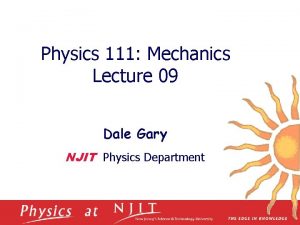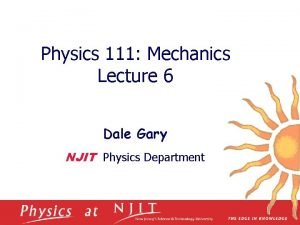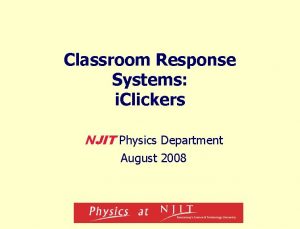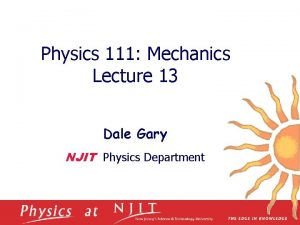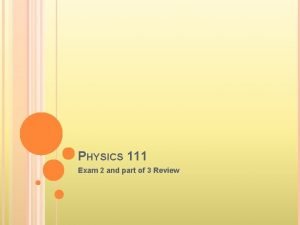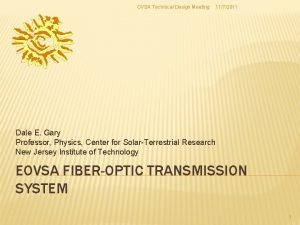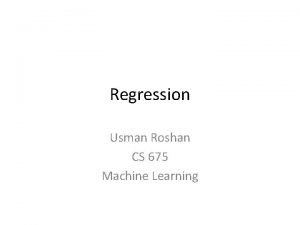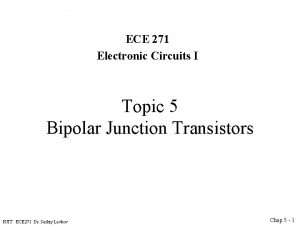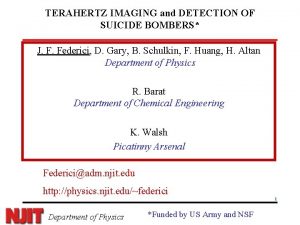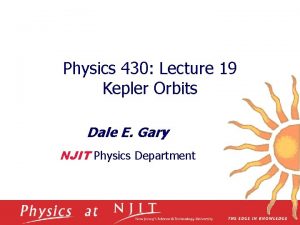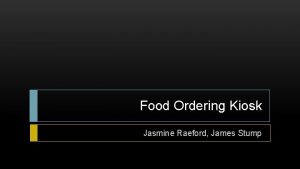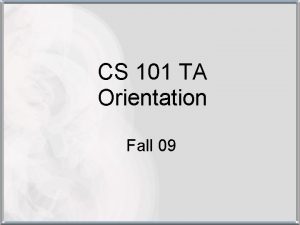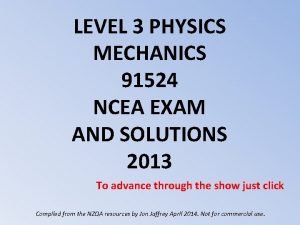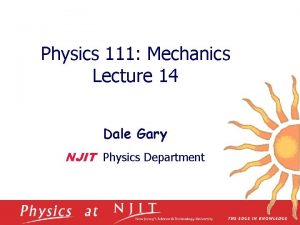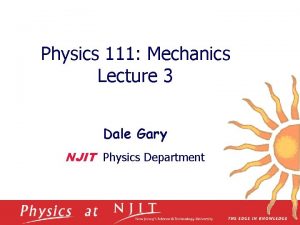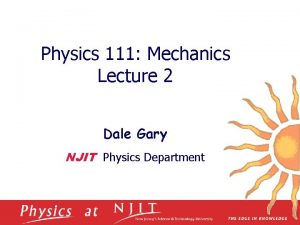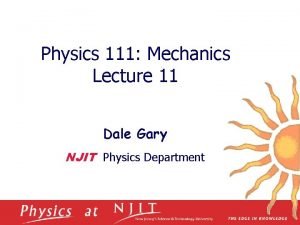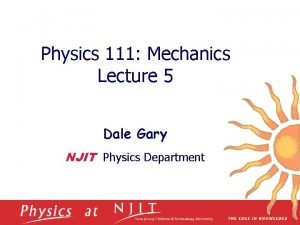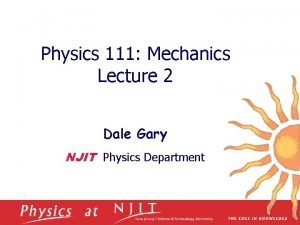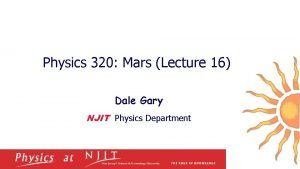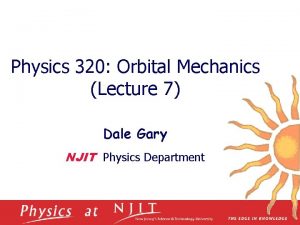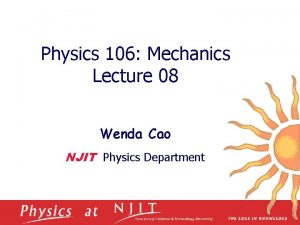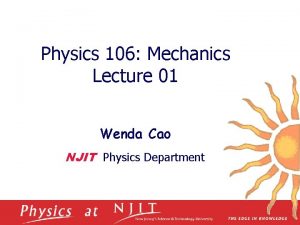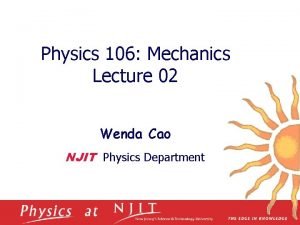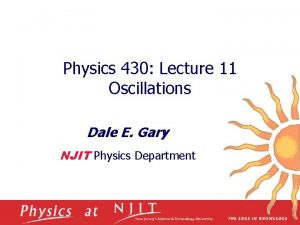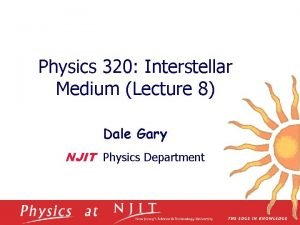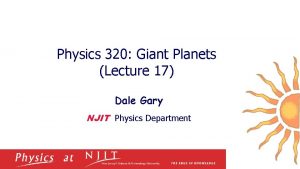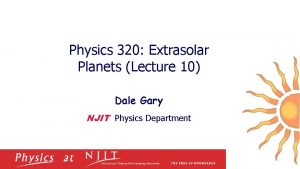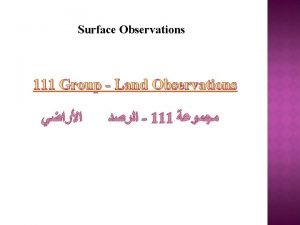Physics 111 Mechanics Lecture 6 Dale Gary NJIT
































- Slides: 32

Physics 111: Mechanics Lecture 6 Dale Gary NJIT Physics Department

Energy q q q Energy and Mechanical Energy Work Kinetic Energy Work and Kinetic Energy The Scalar Product of Two Vectors 29 November 2020

Why Energy? q Why do we need a concept of energy? q The energy approach to describing motion is particularly useful when Newton’s Laws are difficult or impossible to use q Energy is a scalar quantity. It does not have a direction associated with it 29 November 2020

What is Energy? q Energy is a property of the state of a system, not a property of individual objects: we have to broaden our view. q Some forms of energy: n Mechanical: n n n Kinetic energy (associated with motion, within system) Potential energy (associated with position, within system) Chemical Electromagnetic Nuclear q Energy is conserved. It can be transferred from one object to another or change in form, but cannot be created or destroyed 29 November 2020

Kinetic Energy q Kinetic Energy is energy associated with the state of motion of an object q For an object moving with a speed of v q SI unit: joule (J) 1 joule = 1 J = 1 kg m 2/s 2 29 November 2020

Why ? 29 November 2020

Work W q Start with Work “W” q Work provides a link between force and energy q Work done on an object is transferred to/from it q If W > 0, energy added: “transferred to the object” q If W < 0, energy taken away: “transferred from the object” 29 November 2020

Definition of Work W work, W, done by a constant force on an object is defined as the product of the component of the force along the direction of displacement and the magnitude of the displacement q The n n n F is the magnitude of the force Δ x is the magnitude of the object’s displacement q is the angle between 29 November 2020

Work Unit q This n n gives no information about the time it took for the displacement to occur the velocity or acceleration of the object q Work is a scalar quantity q SI Unit n Newton • meter = Joule n n N • m=J J = kg • m 2 / s 2 = ( kg • m / s 2 ) • m 29 November 2020

Work: + or -? q Work can be positive, negative, or zero. The sign of the work depends on the direction of the force relative to the displacement n n n Work Work positive: W > 0 if 90°> q > 0° negative: W < 0 if 180°> q > 90° zero: W = 0 if q = 90° maximum if q = 0° minimum if q = 180° 29 November 2020

Example: When Work is Zero q. A man carries a bucket of water horizontally at constant velocity. q The force does no work on the bucket q Displacement is horizontal q Force is vertical q cos 90° = 0 29 November 2020

Example: Work Can Be Positive or Negative q Work is positive when lifting the box q Work would be negative if lowering the box n The force would still be upward, but the displacement would be downward 29 November 2020

Work Done by a Constant Force q The work W done on a system by an agent exerting a constant force on the system is the product of the magnitude F of the force, the magnitude Δr of the displacement of the point of application of the force, and cosθ, where θ is the angle between the force and displacement vectors: I II IV 29 November 2020

Work and Force q An Eskimo pulls a sled as shown. The total mass of the sled is 50. 0 kg, and he exerts a force of 1. 20 × 102 N on the sled by pulling on the rope. How much work does he do on the sled if θ = 30°and he pulls the sled 5. 0 m ? 29 November 2020

Work Done by Multiple Forces q If more than one force acts on an object, then the total work is equal to the algebraic sum of the work done by the individual forces n Remember work is a scalar, so this is the algebraic sum 29 November 2020

Work and Multiple Forces q Suppose µk = 0. 200, How much work done on the sled by friction, and the net work if θ = 30° and he pulls the sled 5. 0 m ? 29 November 2020

Kinetic Energy q Kinetic energy associated with the motion of an object q Scalar quantity with the same unit as work q Work is related to kinetic energy 29 November 2020

29 November 2020

Work-Kinetic Energy Theorem q When work is done by a net force on an object and the only change in the object is its speed, the work done is equal to the change in the object’s kinetic energy n n Speed will increase if work is positive Speed will decrease if work is negative 29 November 2020

Work and Kinetic Energy q The driver of a 1. 00 103 kg car traveling on the interstate at 35. 0 m/s slam on his brakes to avoid hitting a second vehicle in front of him, which had come to rest because of congestion ahead. After the breaks are applied, a constant friction force of 8. 00 103 N acts on the car. Ignore air resistance. (a) At what minimum distance should the brakes be applied to avoid a collision with the other vehicle? (b) If the distance between the vehicles is initially only 30. 0 m, at what speed would the collisions occur? 29 November 2020

Work and Kinetic Energy (a) We know q Find the minimum necessary stopping distance q 29 November 2020

Work and Kinetic Energy (b) We know q Find the speed at impact. q Write down the work-energy theorem: q 29 November 2020

Work Done By a Spring q Spring force 29 November 2020

Spring at Equilibrium q. F =0 29 November 2020

Spring Compressed 29 November 2020

Work done by spring on block Fig. 7. 9, p. 173

Measuring Spring Constant q Start with spring at its natural equilibrium length. q Hang a mass on spring and let it hang to distance d (stationary) q From so can get spring constant. 29 November 2020

Scalar (Dot) Product of 2 Vectors q The scalar product of two vectors is written as n It is also called the dot product q n q is the angle between A and B q Applied means to work, this 29 November 2020

Dot Product The dot product says something about how parallel two vectors are. q The dot product (scalar product) of two vectors can be thought of as the projection of one onto the direction of the other. q q Components q 29 November 2020

Projection of a Vector: Dot Product The dot product says something about how parallel two vectors are. q The dot product (scalar product) of two vectors can be thought of as the projection of one onto the direction of the other. q q Components Projection is zero p/2 29 November 2020

Derivation How do we show that q Start with q q Then q But q So ? 29 November 2020

Scalar Product q The vectors q Determine the scalar product q Find the angle θ between these two vectors 29 November 2020
 Njit physics 111
Njit physics 111 Classical mechanics
Classical mechanics Dale gary
Dale gary 000 111 000
000 111 000 Njit physics department
Njit physics department Kepler 4 njit
Kepler 4 njit Physics 111 exam 1
Physics 111 exam 1 01:640:244 lecture notes - lecture 15: plat, idah, farad
01:640:244 lecture notes - lecture 15: plat, idah, farad Usman roshan njit
Usman roshan njit Njit cs 288
Njit cs 288 1172011
1172011 App1store
App1store Ivon nunez njit
Ivon nunez njit Food near njit
Food near njit Njit eop office
Njit eop office Cs 675 njit
Cs 675 njit Reverse transfer njit
Reverse transfer njit Eop program
Eop program Njit suicide
Njit suicide Kepler 4 njit
Kepler 4 njit Njit gds hours
Njit gds hours Cs 288 njit
Cs 288 njit Cs 288 njit
Cs 288 njit Cs101 njit
Cs101 njit What is a harmonic wave in physics
What is a harmonic wave in physics Phy101 lecture 1
Phy101 lecture 1 Physics 101 lecture notes pdf
Physics 101 lecture notes pdf Waves physics notes
Waves physics notes Atmospheric physics lecture notes
Atmospheric physics lecture notes Quantum physics vs quantum mechanics
Quantum physics vs quantum mechanics Ap physics quantum mechanics
Ap physics quantum mechanics 91524 answers 2020
91524 answers 2020 Quantum physics vs mechanics
Quantum physics vs mechanics
